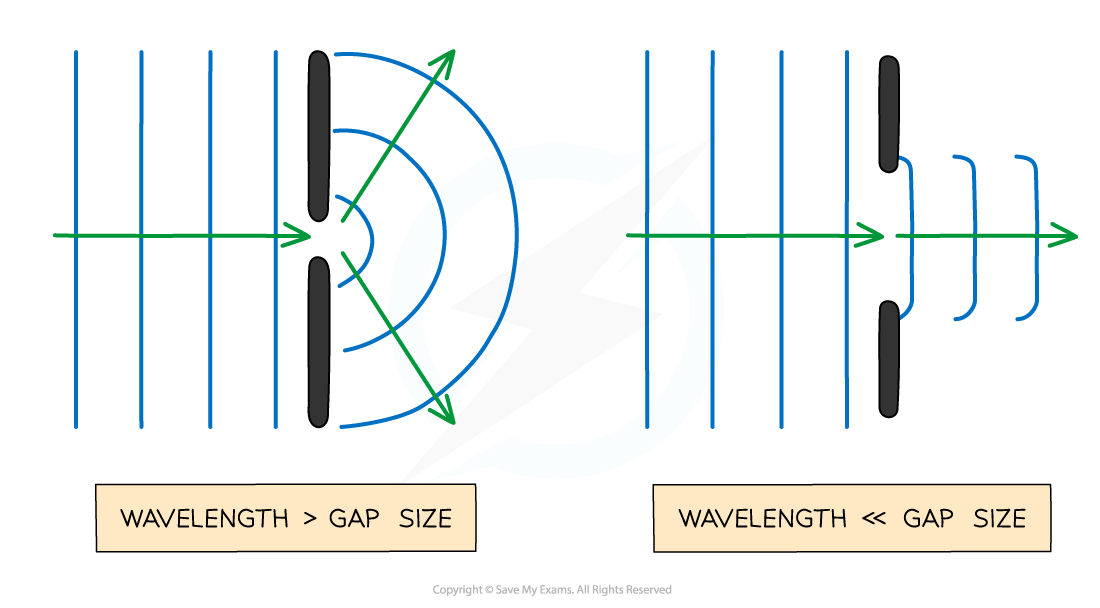Diffraction (Cambridge (CIE) A Level Physics) : Revision Note
What is diffraction?
Diffraction is the spreading out of waves when they pass an obstruction
This obstruction is typically a narrow slit (an aperture)
The extent of diffraction depends on the width of the gap compared with the wavelength of the waves
Diffraction is the most prominent when the width of the slit is approximately equal to the wavelength
Diffraction through a gap

Diffraction: when a wave passes through a narrow gap, it spreads out
Diffraction is usually represented by a wavefront as shown by the vertical lines in the diagram above
The only property of a wave that changes when its diffracted is its amplitude
This is because some energy is dissipated when a wave is diffracted through a gap
Diffraction can also occur when waves curve around an edge:
Diffraction by a barrier

When a wave goes past the edge of a barrier, the waves can curve around it
Any type of wave can be diffracted i.e. sound, light, water
Worked Example
When a wave is travelling through air, which scenario best demonstrates diffraction?
A. UV radiation through a gate post
B. Sound waves passing a steel rod
C. Radio waves passing between human hair
D. X-rays passing through atoms in a crystalline solid
Answer: D
Diffraction is most prominent when the wavelength is close to the aperture size
UV waves have a wavelength between 4 × 10-7 – 1 × 10-8 m so won’t be diffracted by a gate post
Sound waves have a wavelength of 1.72 × 10-2 – 17 m so would not be diffracted by the diffraction grating
Radio waves have a wavelength of 0.1 – 106 m so would not be diffracted by human hair
X-rays have a wavelength of 1 × 10-8 – 4 × 10-13 m which is roughly the gap between atoms in a crystalline solid
Therefore, the correct answer is D
Examiner Tips and Tricks
When drawing diffracted waves, take care to keep the wavelength constant. It is only the amplitude of the wave that changes when diffracted.
Diffraction experiments
The extent of diffraction depends on the width of the gap compared to the wavelength of the waves
For gaps that are much much smaller than the wavelength of the wave, no diffraction occurs
For gaps that are much much bigger than the wavelength of the wave, no diffraction occurs
When the wavelength of the wave and the width of the gap are similar in size, then diffraction occurs:
When the wavelength is bigger than the gap, more diffraction occurs,
The wave spreads out more after passing through
When the wavelength is smaller than the gap, less diffraction occurs
The wave spreads out less after passing through
Size of the gap and diffraction

The size of the gap (compared to the wavelength) affects how much the waves spread out
Examples of diffraction include:
Radio waves moving in between or around buildings
Water waves moving through a gap into a harbour
Ripple tanks
Ripple tanks are a common experiment used to demonstrate diffraction of water waves
Through a gap
Around a barrier
The amount of diffraction that occurs can be changed by changing the wavelength of the waves compared to the gap size
Changing the gap size for diffraction in a ripple tank

When the gap size is bigger than the wavelength less diffraction occurs and the waves spread out less after passing through
Examiner Tips and Tricks
Familiarising yourself with the wavelength of electromagnetic waves is essential for identifying which wave will cause the greatest diffraction effect for a given gap width.

You've read 0 of your 5 free revision notes this week
Sign up now. It’s free!
Did this page help you?

